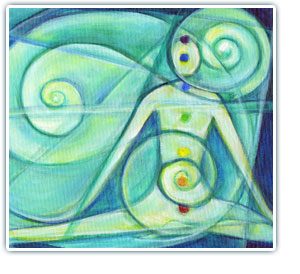
Maintaining good physical and mental health requires that we stay in balance, and according to Eastern philosophy that also includes chakra balancing for improved health and vitality. In Chinese and Indian medicine, this balance is represented by the flow of life energy throughout the body. When this flow is blocked or interrupted, it can throw a person out of balance. In Chinese medicine this involves qi and meridians. In Indian medicine, this life energy flows through the seven major chakras.
A chakra is the center of activity that receives, takes on, and releases lifeforce energy throughout the body. Chakra is the Sanskrit word for “wheel” and derives from the fact that the chakras are in constant motion like wheels as they receive and facilitate the lifeforce energy flow. A chakra processes our life experiences in three important ways: feelings and emotions, records of events that happened in your past, and a mental assembly of beliefs and conclusions derived from life events. The seven major chakras start at the base of the spine with the root chakra and travel up the center of the body until reaching the top of the head at the crown chakra.
The seven chakras must be in balance in order for the flow of this life energy to work unimpeded. When they are blocked, stuck, or even fully wide open, the result is an imbalance. There are several things that can block a chakra. These blocks are usually emotionally based or mental in nature.
What is a Blocked Chakra?
One example of an issue that often blocks a chakra is childhood trauma. Anyone who experienced abuse or neglect as a child knows that this experience has an enormous effect on how they view and deal with the world around them. The second chakra, which is below the naval, is sometimes referred to as the home of the inner child because it stores much of the childhood experiences that created some impact.
Another example of a block to a chakra is tension in the upper abdomen. This is where the third chakra is and where fear, worry, and anxiety are often centered. When this chakra is blocked with these emotional issues a person can experience “butterflies” in the stomach, tightness, or indigestion. A person whose solar plexus area are tensed up is most likely under a significant amount of stress. Emotional stress often manifests itself in physical symptoms.
Other conditions that contribute to chakra imbalance are cultural conditioning, a limited or inflexible belief system, bad habits, physical injuries or emotional reactions, a lack of attention, feeling shut down, and other coping/defense mechanisms one has developed in life to deal with problems.
Chakra Balancing from the Outside In
The method to remedy this situation is chakra balancing. There are several methods that a person can utilize to put things back into balance. Common methods which work to help put the chakras back into balance are yoga, tai chi, qi gong, physical exercise, meditation, energy healing, and a person’s diet. Other methods include reiki (a Japanese method of stress reduction which utilizes the laying of hands on a person to improve the flow of life force energy), color therapy, EFT (emotional freedom technique), guided visualizations, chakra balancing using the laying on of hands, or the use of a pendulum, crystals or gemstones, and positive affirmations. Visit this article for more on the chakra clearing. That article explains what the issues are related to each of the chakras.
Some of these methods are “outside-in”, meaning that they use external methods to heal from the outside to the inside. Health issues are often a sign of imbalanced chakras because the chakras respond to our interpretations of events. If we react with negative emotions this will have an effect on our chakra system which, in turn, affects the open flow of lifeforce energy throughout the body. Of course, not all problems are due to emotional or mental issues, but even in cases where genetics or other environmental factors lie at the cause, addressing the symptoms through various forms of chakra healing or chakra balancing can often speed recovery or remission.
The Importance of Working from the Inside Out
However, some people feel that the best chakra balancing is “inside out” or healing from the mind outward in conjunction with healing from outside in. Most emotional issues have roots in the mind because they affect how a person thinks, behaves, feels, and how they relate to other people. Until the judgments and emotional issues are addressed, external methods of healing usually aren’t as effective by themselves in the long term because the issue will often resurface in the same or another way.
In the above example, exercise, diet change, and the other methods of “outside in” remedies will no doubt help with the symptoms, but an unhealthy condition may return if the underlying mental and emotional causes are not addressed. An obvious example is with those who are overweight who lose the weight but end up gaining it back, either because they medicate themselves with food, or they have unresolved emotional issues. To put everything back into balance, the person must also work out the mental reasons why they turn to food for comfort.
Chakra balancing from the inside out involves retraining the mind. This can be achieved through activities such as meditation, affirmations, or guided visualization. A person may seek to practice any of these methods because they believe in healing the whole person. Modern medicine, while important, doesn’t always focus on the whole person. Instead, the focus is usually on relieving the symptoms. Medications or physical therapy relieve the physical symptoms, but do little to cure the root cause. Holistic approaches heal the whole person instead of masking symptoms. My audio program titled “Chakra Healing” will lead you through guided healing and clearing meditations for each of the chakras.
